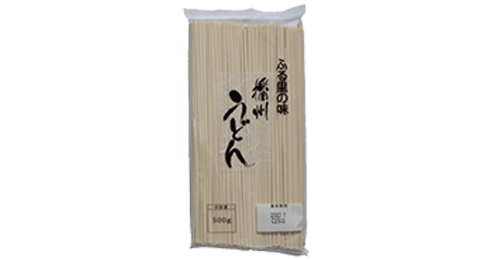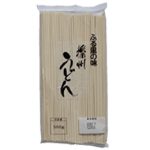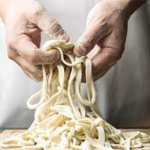Udon noodles white and glossy in appearance, with an ample girth. They feel silky and pleasantly slippery on the lips, but have a satisfying bite to them. Udon noodles have little taste of their own: it is the broth or dipping sauce that gives each dish its character.
The right selection of sake and tea service equipment not only brings a theatrical touch to the dining experience, but also unveils the true nature of the iconic Japanese beverages depicting a keenness for excellence.
FURUSATONOAJI BANSHU UDON
| Origin: | BANSHU, HYOGO, JAPAN |
| Unit Size: | 500g |
Udon noodles had a noble birth. They were introduced to Japan from China in the 18th century as dumplings to be eaten between meals- an earlier version of dim sum. With the development of noodle-making technique, udon changed their shape from a round dumpling to a noodle. Udon were eaten in the imperial and aristocratic palaces and in Buddhist temples. These noodles became more widely available to ordinary people during the Middle Ages and were one of the most popular street foods by the 18th century.

The technique of making udon noodles was imported in the 6th century from China. To this day in China there are three basic methods for making noodles: hand-pulling, rolling and cutting, and paring/peeling. Only the first two methods were introduced to Japan, where they still can be seen. Watching hand-pulled noodles being made is like watching a magic trick: a noodle master turns a ball of dough into longs strands of noodles after just a few minutes of stretching. Udon flour is a combination of equal amounts of wheat strong and plain flour, which is mixed with approximately half of its volume with a water and a pinch of salt to form a dough. The additional of salt not only gives the noodles more flavor but also breaks down the protein content of the flour making the dough more elastic and workable.
- TASTE PROFILE
- CULINARY USE
- COOKING INSTRUCTIONS
- STORAGE
There are three basic methods for cooking udon noodles in Japan, all of which involve boiling them first. They can then be served in hot soup, served hot or cold with a dipping sauce or stir-fried ( yuki-udon) with other ingredients.
- Bring a large pan of water to boil and add udon noodles.
- Boil for 10 -12 minutes. Test by plucking a noodle from pot, plunging it into cold water, then biting. Noodle should be tender with no hard core; outer surface should be slippery but not overly soft. (This condition is what the Japanese refer to as koshi, or “substance,” just as the Italians enjoy their pasta al dente.) If necessary, cook for another minute and check again.
- If you will be serving noodles hot, scoop them up into a strainer and lift from pot to drain. (Do not pour off cooking liquid; boiling water in pot can be used both to re-heat noodles, and to warm bowls in which they will be served.)
- If you will be serving noodles cold, drain them.
- Whether serving noodles hot or cold, rinse them well under cold running water to remove surface starch that would otherwise make them gummy. Then drain.
- Set noodles aside until ready to eat — they can be held for up to several hours (refrigerate if holding for more than 20 minutes). When ready to use, rinse noodles in boiling hot water if serving them in hot soup, or cold water if serving chilled as a salad.
Best to store in dry cool place away from direct sunlight. Once the original packaging is open, transfer into an airtight tapper ware.






